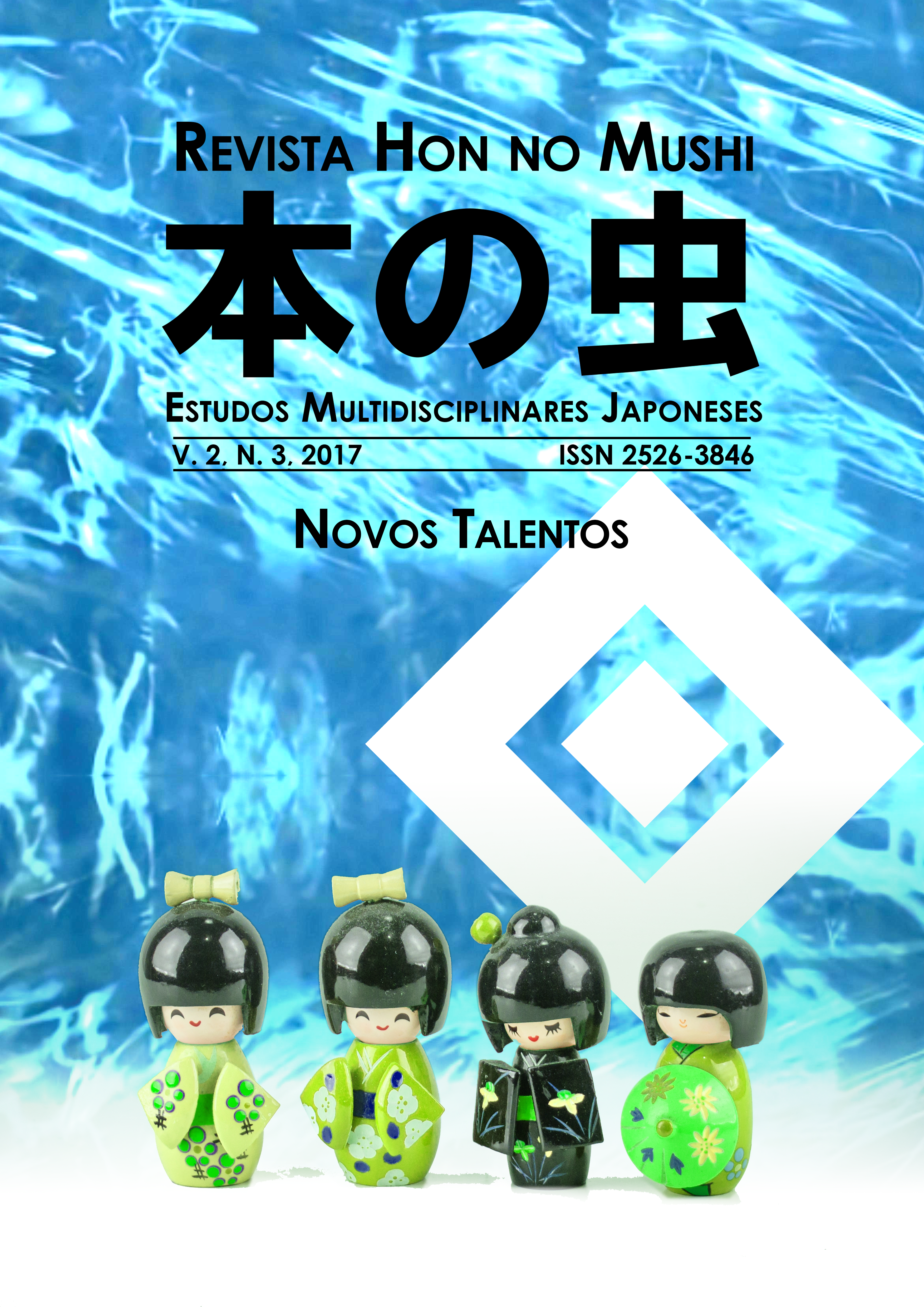JOÃO RODRIGUES TÇUZU AND HIS BOOK NIHON KYŌKAISHI
Keywords:
João Rodrigues Tçuzu, Nihon kyōkaishi, Japão, Século Cristão, NanbanjinAbstract
The article seeks to present and reflect about the life and book Nihon kyōkaishi ("History of the Church in Japan") written by the Portuguese interpreter and Jesuit João Rodrigues Tçuzu – whose under the service of the Toyotomi Hideyoshi, Tokugawa Ieyasu, and the Visitor General Alessandro Valignano – was a witness of the various socio-economic transformations that took place in the archipelago. This is the reason why we will study the book, in particular the description of cha no yu (tea ceremony), through the methodology of Microhistory, in order to understand how the formation of modern Japan was seen by the first foreigners during the so-called Christian Century 1543-1643) and which aspects was born inside the nanbam culture.
Downloads
References
COOPER, Michael. They came to Japan: An anthology of European reports on Japan, 1543-1640. Ann Arbor: Center for Japanese Studies – University of Michigan, 1995.
GERALD, H. Anderson. Biographical Dictionary of Christian Missions. Michigan: Wm. B. Eerdmans Publishing, 1999.
HALL, John W. (org.). The Cambridge History of Japan: Vol. 4. Early modern Japan. Cambridge: Cambridge University Press, 2006.
HIOKI, Naoko Frances. Tea ceremony as dialogical space: The Jesuits and the way of tea in early modern Japan. Engaging Particularities VI, Boston College, Theology department, 2008.
KOREN, Leonard. Wabi-Sabi for Artists, Designers, Poets, and Philosophers. Berkeley: Stone Bridge Press, 1994.
LIDIN, Olof G. Tanegashima: the arrival of Europe in Japan. Copenhagen: NIAS Press, 2004.
MATSUDA Kiichi. Nanban no bateren. Tōkyō: Chōbunsha, 1991.
MIKI Seiichirō. Teppō to sono jidai. Tōkyō: Yoshikawakōbunkan, 2012.
MURAI Sanae. Kirishitan kinsei to minshū no shūkyō. Tōkyō: Yamakawa shuppansha, 2002.
OKA Mihoko. A memorandum by Tçuzu Rodrigues: The office of Procurator and Trade by the Jesuits in Japan. Bulletin of Portuguese/Japanese Studies, n° 13, Nova de Lisboa University, Portugal, dez/2006, pp. 81-102
______ . A Great Merchant in Nagasaki in 17th Century - Suetsugu Heizō and the System of ‘Respondência’.
Bulletin of Portuguese/Japanese Studies Vol.2, Centro de História Além-Mar, Lisbon, Jun 2001. Disponível em <http://www.redalyc.org/pdf/361/36100203.pdf> Acesso em: 12 dez/2015, pp. 37-56
______ . Iezusukai Nihonbōeki no kyo to jitsu ―“Nihon purokuradōru oboegaki” no shōkai. In: Tōkyōdaigaku Shiryōhensan-sho Kenkyūkiyō. n. 17, March/ 2007, pp. 146-162
OKAKURA Tenshin. Cha no hon. Akira, Asano (Yaku). Tōkyō: Kōdansha, 2015.
OLIVEIRA, Francisco Roque de. “Michael Cooper (ed.), João Rodrigues’s Account of Sixteenth-Century Japan. London: The Hakluyt Society, 2001”, Bulletin of Portuguese/Japanese Studies, Lisbon, New University of Lisbon, 2004, Volume 8, pp. 115-122 Disponível em <http://www.redalyc.org/articulo.oa?id=36100807> Acesso em 18 out. 2015.
PINA, Isabel. Joao Rodrigues Tcuzu and the controversy over chistian terminology in China. The Perspective of a Jesuit from the Japanese Mission Bulletin of Portuguese In: Japanese Studies, num. 6, june/2003, pp. 47-71 Universidade Nova de Lisboa, Lisboa, Portugal. Disponível em <http://www.redalyc.org/pdf/361/36100603.pdf >. Acesso em: 24 Set. 2017
Porutogaru to nanban bunka ten: Mezase, tōhō no kuniguni. Sezon bijutsukan: Shizuoka kenritsu bijutsukan-hen, 1993.
PRAZERES, Raquel Sofia Baptista dos. Visões do Oriente. O Budismo no Japão aos olhos de João Rodrgigues Tçuzu. Dissertação de Mestrado em História moderna e dos descobrimentos. Faculdade de Ciências Sociais e Humanas. Universidade Nova Lisboa, Portugual, 2012.
ROCHA, Rui. Os Jesuítas no Japão e a Arte do chá. Review of Culture. n. 46, ano 2014, pp. 80-93 <https://www.researchgate.net/publication/280067142OsJesuitasnoJapaoeaArtedoCha> Acesso em: 5 jul. 2015.
RODORIIGESU, Joan. Nihon Kyōkaishi (Jō). Tsutomu Ema; Yasuhiko Sano; Tadao Doi; Nobuo Hamaguchi(Yaku). Daikōkaijidai Sōsho IX. Tōkyō: Iwanamishoten, 1967-70
______ . Nihon Kyōkaishi (Ge). Mineo Ikegami; Shuntarō Itō; Yasuhiko Sano; Minoru Chōnan; Tadao Doi; Nobuo Hamaguchi; Kiyoshi Yabuuchi(Yaku). Daikōkaijidai Sōsho X. Tōkyō: Iwanamishoten, 1967-70
______ . Nihon daibunten. Tōkyō: Bunkashobōhakubunsha,1969.
______ . This island of Japan. Tradução Michael Cooper. Tōkyō /New York: Kodansha International LTD, 1973.
SADLER, Arthur L. Cha-no-yu: The Japanese tea ceremony. Rutland: C E Tuttle, 1963.
SANSOM, G. B. The Western World in Japan. A study in the interaction of European an Asiatic cultures. Tōkyō: Charles E Tuttle Company, 1987.
TERAOKA Miyoko. The Japanese Tea Ceremony and Christianity: The Influence Each Had Upon the Other During the Most Important Period in the Development of the Tea Ceremony - the Christian Century in Japan (1549-1650), Doctoral Dissertation, Seton Hall University. Department of Asian Studies, 1984.
THOMAZ, Luis Filipe. De Ceuta a Timor. Lisboa: DIFEL, 1994.
YAMASHIRO, José. Choque Luso no Japão dos séculos XVI e XVII. São Paulo: IBRASA, 1989.
YOSHITOMO Okamoto. The Namban Art of Japan. New York/ Tōkyō: Weatherhill/ Heibonsha, 1972.
Downloads
Published
Issue
Section
License
The copyright belongs to the Hon Journal in Mishi - Multidisciplinary Japanese Studies and to the authors of each article. All work or part of it, when quoted or used, must be referenced.




